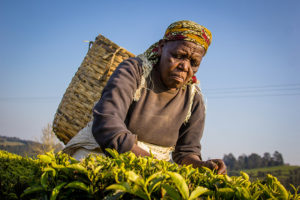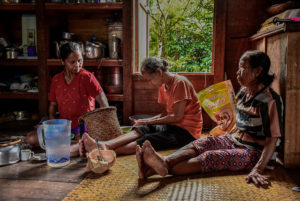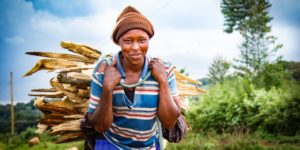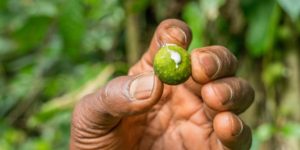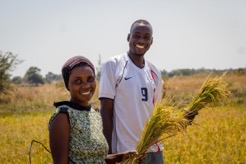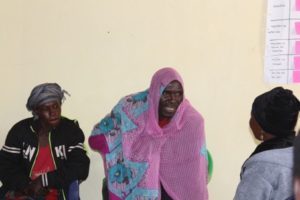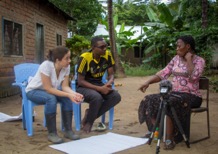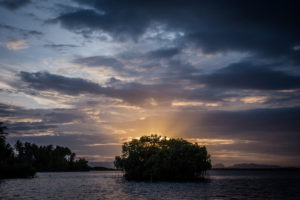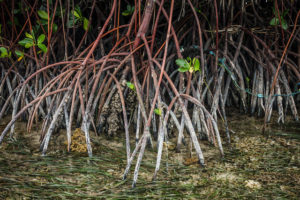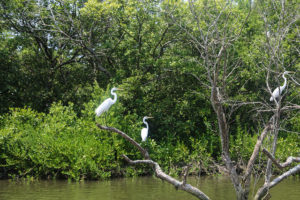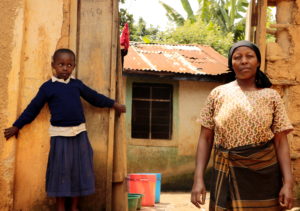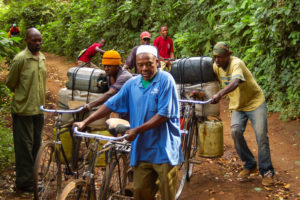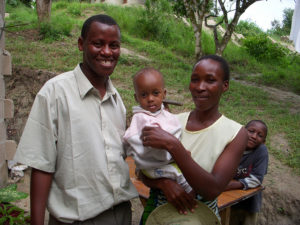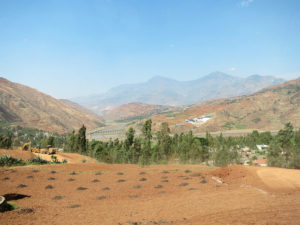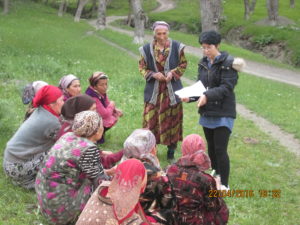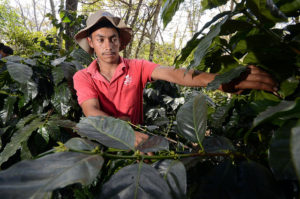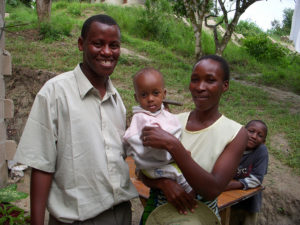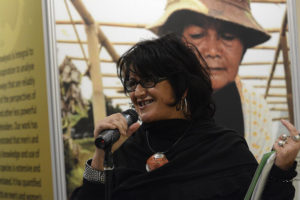How secure resource rights help communities in Africa restore forests and build local economies
“Landscape restoration is not new,” said Steven Lawry, former director of CIFOR’s Forests and Governance Research portfolio. “But global and national commitments such as the Bonn Challenge and AFR100 and the urgency of addressing climate change mean that a qualitatively different approach is needed if we’re going to achieve the kind of success that we aspire to.”
Lawry used these words last October, during the interactive “Restoring Forests, Restoring Communities” session at the Global Landscapes Forum in Accra, Ghana. Supported by a panel of conservation experts with experience across the continent, Lawry put communities – and the question of secure land tenure rights – at the heart of that “qualitatively different approach”. [Full session can be replayed entirely here]
Shinyanga: Restoring communities in Tanzania
The story begins in Shinyanga, northern Tanzania, with a landscape restoration project that is – or perhaps was – held up as a bright example of successful collaboration between government, conservation scientists and local communities.
Priscilla Wainaina, agricultural economist at World Agroforestry (ICRAF), led a research team to investigate what made the Shinyanga restoration so successful.
The region suffered from severe landscape degradation as early as the 1930s when British colonial authorities encouraged the clearing of woodlands for various reasons, including the eradication of disease-carrying tsetse flies and increased demand for wood. But this was only the beginning. “In the 1960s and 70s, cash crops – mainly cotton and tobacco – intensified this degradation,” Wainaina said.
The degradation was so severe that, by the 1980s, Shinyanga had become known as the “desert of Tanzania”. “That’s when the government of Tanzania, together with ICRAF, came up with the HASHI restoration project,” Wainaina explained.
Building on the existing local practice of Ngitili fodder reserves, the HASHI restoration project encouraged cattle farmers to plant trees on their grazing land. As they matured, these trees supplied the farmers with fodder for livestock, as well as wood they could use or sell for fuel and construction.
When the HASHI project started in 1986, there were only around 600 hectares of land managed under the Ngitili system. By the time the project ended in 2004, over 250,000 hectares of Ngitili had been restored and were being managed by local communities.
In 2004, management of the restored landscapes were taken over by local communities under the leadership of the village councils, supported by a government body dedicated to community empowerment.
The project was hailed as a triumph by conservation scientists across the globe. But recently there have been troubling signs for the future of Shinyanga, and the problem centres around land tenure rights.
“This goes beyond just troubling”
“When it comes to land tenure rights in Tanzania,” Wainaina said, “land is owned by the state, but it’s managed by local households and communities. This gave communities an incentive to restore their landscapes so as to strengthen these property rights.”
And, for the last 30 years, this is exactly what happened: the customary rights of local communities to the communal restoration areas had, in the words of Priscilla Wainaina, “grown stronger”.
“But in 2018,” Wainaina continued, “a new ministerial directive to shift some of these communally-owned restoration areas to the state was issued, so they can be state managed.”
Wainaina was quick to add that the state had good intentions for this decision. Naturally, the Tanzanian government has access to much greater resources, both human and financial, to better manage the restoration in Shinyanga than the local communities do.
But Wainaina also reported that, “the local communities feel like [the decision] was not well communicated: it was top-down as opposed to participatory”.
“Now communities are not sure about the future ownership of the communal restoration areas,” Wainaina said. Because it is the local communities who are responsible for the majority of the landscape restoration, this new insecurity is, according to Wainaina, “really clouding the restoration efforts”.
Although her concerns were stated in the straight-forward language of an agricultural economist, Lawry was quick to pick up on the significance of Wainaina’s comment. “It’s a bit troubling to hear that there are now questions in the air about the ability of the communities to retain the tenure rights that have contributed to the success of the project,” he said.
Chris Buss, Director of the Forest Programme at the International Union for Conservation of Nature (IUCN), went further: “We use Shinyanga as one of the great examples of restoration,” he said. “If the land and trees are being taken away under different ownership systems, then this goes beyond just troubling. It goes to the heart of what we’re trying to achieve.”
Secure land tenure: “The heart of what we’re trying to achieve”
Secure land tenure is the foundation of successful landscape restoration, as Steven Lawry explained: “Research – considerable research, in fact – identifies secure tenure as a necessary condition for successful community forestry, including for forest landscape restoration adoption.”
Landscape restoration goes far beyond simply planting trees. It takes a much broader view of degraded sites, restoring the whole mosaic of land uses that draw from and contribute to the landscape. Without the involvement of the local communities who live and work on the land, such a holistic approach is impossibly difficult. But without secure tenure, what motivation do local communities have to invest in the landscape?
Tangu Tumero, Principal Forestry Officer at the Department of Forestry in Malawi, tells a story that illustrates the same motivations, but on an individual scale.
“In Malawi, we have a tradition in some cultures where, when a man marries a woman, the man moves to live in the woman’s community. But, if the marriage ends, he must go back to his village,” Tumero said. “As long as he feels like he doesn’t belong with this community, he is not going to plant a tree from which he would benefit [in the future]. ”
This thinking plays out on a larger scale when the whole community does not feel like they have rights to the land they work. “Secure tenure motivates investments in land, including community investments in forest landscape restoration,” Lawry explained.
Unfortunately, as Wainaina showed with her research on Shinyanga, secure land tenure is far from the norm.
Interview with Priscilla Wainina during GLF
“Indigenous peoples and local communities occupy some 50 percent of the total land area in the tropics,” Lawry said, “but only have legal rights to a very small portion of those resources and governments still struggle with how to understand and secure customary rights.”
Restoration management is already a very complex task, but it is made even more complex when, as Wainaina discovered in Shinyanga, projects fail to take account of who exactly owns the land and to accord statutory protection to existing customary land tenure arrangements.
Chris Buss learned this lesson the hard way when he was working in Malawi. “There was a fuel wood project that planted millions of trees,” he said. “It was very successful for three years, until the trees got to a decent size and all the local chiefs said ‘These are our trees and we’re going to harvest them now.’”
“Over three or four years, the project looked very successful,” Chris said, “but we hadn’t addressed the critical tenure issues and the trees were cut down.”
Tumero agreed that understanding the local context is paramount. “When we’re developing our programs,” she said, “we make sure that they are locally driven as much as possible. Otherwise, we can overlook some of these things that look minor but are going to be very crucial in terms of how we make progress.”
Customary land rights are typically not written into law but are rather rights that are recognised by the local community. Importantly, customary tenure principles grant all bona fide members of the local community land as a social right. However, the introduction of individual, statutorily recognized rights, can have the effect of dissolving long-standing customary rights, making poorer community members particularly vulnerable; hence, the importance of extending statutory recognition to existing customary rights, at a legal status equal to private land and state land.
The absence of statutory recognition of customary tenure creates what Patrick Ranjatson, professor in Forestry and Environment at the University of Antananarivo, calls “invisible communities”. “Community is always there, but people have a tendency to overlook them,” Ranjatson said. “Government agencies, NGO projects and even sometimes the community’s own members are not aware of the importance of their community.”
“Simply put,” Steven Lawry concluded, “the future of forest landscape restoration is limited if we do not solve the tenure problem where the problem exists.”
Return to Shinyanga: Choosing Intrinsic over Extrinsic Incentives
For solutions to the problems of land tenure rights and invisible communities, we return to Shinyanga, and Priscilla Wainaina.
“Restoration in Shinyanga has been going on for 30-plus years,” Wainaina said. “When the HASHI project ended in 2004, the communities, with support from the government, were able to continue the restoration efforts. So, what made restoration so successful in this landscape?”
Wainaina’s research (awaiting publication) found the answer to be, not one incentive in particular, but a pattern of incentives and disincentives that complemented each other.
“The incentives that stood out particularly were conservation benefits,” Wainaina explained, “the ecological, economic or even cultural benefits communities derive from restoration.”
These conservation benefits were predominantly what Wainaina described as intrinsic motivators. “These are motivators that rely on self-desire more than external factors,” Wainaina explained, “and these intrinsic motivators were the key drivers of restoration in Shinyanga.”
“Restoration in this area focussed more on local people and local knowledge and that focus really got the communities involved, in addition to the other actors,” Wainaina said. “The communities, together with their village governments, owned the projects and that was a really key motivator.”
Patrick Ranjatson issued a final note of caution. “Strengthening communities doesn’t mean that we strengthen communities to the detriment of the state,” he said. “If there are people doing slash-and-burn agriculture, then the forest will be finished very rapidly. We need to find this balance, so if it’s not local community who bring this idea of sustainability, then it has to be either the government or partners such as NGOs.”
Wainaina’s research also found that extrinsic motivators – such as top-down cash incentives – were not as important for restoration in Shinyanga as policy-makers might imagine. “External motivators, although they supported the restoration, they were not as strong as the intrinsic ones,” she explained.
Wainaina gave the example of the United Nations REDD+ programme, which uses cash incentives to encourage the reduction of net emissions of greenhouse gases by improving forest management and restoration in developing countries.
“REDD+, although it’s usually a motivator in most of the restoration projects in most countries, didn’t actually achieve the benefits they intended in Tanzania because it was a pilot project,” Wainaina said. “It only ran for four years and then it was gone. The discontinuation was a disappointment for the farmers and the local community.”
Extrinsic incentives like REDD+ need careful deployment, otherwise they can back-fire and discourage communities from supporting landscape restoration.
A surer bet for successful restoration, according to Wainaina’s research, is to empower local communities with intrinsic motivators like education and land rights that will secure for them the ecological, economic and cultural benefits from conservation.
“We hope that, with participation through the village government and the national government, they will reach a consensus on the way forward in regards to land tenure rights,” Wainaina said.
As for Steven Lawry’s “qualitatively different approach”, these researchers believe that approach must include land rights for local communities.
“Most of these communities are advocating for registration of their land rights,” Wainaina said. They feel as if this is the only way they can secure the benefits that they get from this restoration. They started the restoration areas, they managed them successfully for the past years and they feel like they still have the capacity to do it.”
References
- Toward a tenure-responsive approach to forest landscape restoration: A proposed tenure diagnostic for assessing restoration opportunities, Land Use Policy, 2018
- Integrating tenure and governance into assessments of forest landscape restoration opportunities, CIFOR Infobrief, 2019
- Tenure challenges to implementing forest landscape restoration in northwestern Madagascar, CIFOR Infobrief, 2019
- Fostering tenure security for forest landscape restoration in Ethiopia: Creating enabling conditions for the 2018 Forest Proclamation, CIFOR Infobrief, 2019
- A diagnostic for collaborative monitoring in forest landscape restoration, CIFOR Infobrief, 2019
Further read/blogs
- Forest restoration and democracy: Making communities visible in Madagascar, Forest News, 2019
- Restauration des forêts et démocratie : donner de la visibilité aux communautés de Madagascar
By David Charles, Communication Specialist
Participants: Chris Buss (IUCN); Patrick Ranjatson (ESSA-Foret, Madagascar); Priscilla Wainaina (ICRAF-Nairobi); Tangu Tumero (Forestry Dept—Malawi); and Steven Lawry, Moderator (CIFOR).
Funding from the CGIAR Collaborative Research Programs on Policies, Institutions and Markets (PIM) and Forests, Trees and Agroforestry (FTA) supported the event. FTA is the world’s largest research for development program to enhance the role of forests, trees and agroforestry in sustainable development and food security and to address climate change. CIFOR leads FTA in partnership with Bioversity International, CATIE, CIRAD, INBAR, ICRAF and TBI. FTA’s work is supported by the CGIAR Trust Fund.












